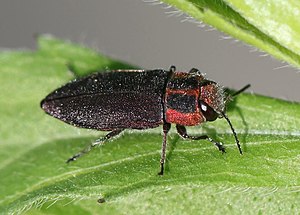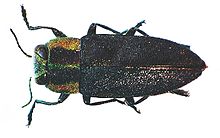Small elm jewel beetle
| Small elm jewel beetle | ||||||||||||
|---|---|---|---|---|---|---|---|---|---|---|---|---|

Little elm jewel beetle ( Anthaxia manca ) |
||||||||||||
| Systematics | ||||||||||||
|
||||||||||||
| Scientific name | ||||||||||||
| Anthaxia manca | ||||||||||||
| ( Linnaeus , 1776) |
The Little Elm jewel beetle ( Anthaxia manca ) is a beetle from the family of jewel beetles (Buprestidae). With a length of seven to eleven millimeters, it is one of the larger species of the genus Anthaxia . The color is reminiscent of the larger males of the Hungarian jewel beetle ( Anthaxia hungarica ), but in contrast to the small elm jewel beetle, the wing covers are indented, making part of the abdomen visible from above.
Like most jewel beetles, the species is specially protected by law in accordance with the Federal Species Protection Ordinance. In the Red List of Endangered Species in Germany and Saxony-Anhalt , the species is listed under Category 2 (endangered). In Schleswig-Holstein it is considered to be extinct or missing , in Brandenburg as threatened with extinction . In Rhineland-Palatinate , it is classified as endangered (category 3).
Notes on the name
The species was first described by Linnaeus in 1776 under the name Buprestis manca . The description does not contain any reference to the species name mánca ( Latin for mutilated). The name Dutch elm beetle indicates the type of tree in which the beetle usually develops. The addition "small" distinguishes the beetle from the great elm splendor beetle .
The genus name Anthaxia is from Altgr. άνθος ánthos, "blossom", and άξιος áxios, "worth" derived and is intended to denote beautifully drawn beetles.
The genus Anthaxia is represented in Europe in four subgenera with over a hundred species. There are over thirteen hundred species worldwide.
Characteristics of the beetle
The head is much wider than long and up to the rear edge of the big eyes in the neck shield withdrawn. The eyes cover the sides of the head and are brought closer together at the top (picture 1, picture 3). The short antennae do not reach the rear edge of the pronotum. They are bluntly serrated and eleven-limbed. The upper lip ( labrum ) is bilobed. The upper jaws ( mandibles ) are strong, curved and pointed. They have a blunt tooth on the inside. The jaws are long, the end link spindle-shaped and truncated. The last link of the lip button is also elongated and truncated.
The forehead is long and densely hairy with whitish hair (picture 3). This hair is also found on the underside of the body as well as on the rails and thighs of the legs . (Picture 2)
The elytra are flat and cover the abdomen when viewed from above. They are without stripes or rows of dots, but densely dotted. In the front two-thirds, their side edges run parallel, they narrow towards the tip. The wing covers are monochrome brown-bronze, and their side edge is not contrasted in color.
The pronotum is metallic copper-red and has two dark longitudinal spots. It has an indistinct longitudinal furrow and is wrinkled. The wrinkles are emphasized in the transverse direction. The sides of the pronotum are rounded slightly convex over the entire length ; at the front they are angled. The rear edge of the pronotum is almost straight, its front edge only slightly double-indented. The scutellum is small and triangular.
The front hip cavities , in which the front legs are turned, are open to the rear. The front hips are spherical and separated by a broad extension of the front chest. This extension ends in a point that bridges the mid-breast and thus apparently divides it (Fig. 4). The rear hips lie broadly against the rear chest and are hollowed out towards the back to partially accommodate the rear legs ( thigh covers ). The tarsi are all five-limbed, the claws imperforate.
Occurrence
The beetles are widespread in Central Europe mainly in the southwest. They are found there from April to July mainly on the wood of the breeding trees, more rarely on flowers. The beetles are also found in Southern Europe, Eastern Europe, North Africa and Asia.
Way of life
The warmth-loving species can be found in sunny floodplains, alluvial forests and parks. The beetles stay on sun-exposed trunks and fathers, and occasionally on brushwood that is infested by bark beetles.
The larvae live under the bark and in the wood of elms ( Ulmus ) and linden ( Tilia ). They take two to three years to develop.
literature
- Heinz Joy, Karl Wilhelm Harde, Gustav Adolf Lohse: The beetles of Central Europe . tape 6 : Diversicornia . Spectrum, Heidelberg 1979, ISBN 3-87263-027-X .
- Gustav Jäger (editor): CG Calwer 's Käferbuch . K. Thienemanns, Stuttgart 1876, 3rd edition
- Klaus Koch : The Beetles of Central Europe Ecology . 1st edition. tape 2 . Goecke & Evers, Krefeld 1989, ISBN 3-87263-040-7 . P. 96
Individual evidence
- ↑ Fritz Brechtel, Hans Kostenbader (ed.): The splendor and stag beetles of Baden-Württemberg , Eugen Ulmer Verlag Stuttgart 2002, ISBN 3-8001-3526-4
- ↑ Red lists at BioNetworkX
- ↑ C. Linnaeus: 1767: Systema naturæ, Tom. I. Pars II. Editio duodecima reformata first description page 537: 1067, no.10
- ↑ Sigmund Schenkling: Nomenclator coleopterologus 2nd edition Jena 1922 Explanation of the scientific beetle names (species) in short form
- ↑ Sigmund Schenkling: Nomenclator coleopterologus 2nd edition Jena 1922 Explanation of the scientific beetle names (genus) in short form
- ↑ Anthaxia at Fauna Europaea. Retrieved March 23, 2013 Anthaxia Anthaxia (subgenus) from Fauna Europaea. Retrieved March 23, 2013 Anthaxia Cratomerus (subgenus) from Fauna Europaea. Retrieved March 23, 2013 Anthaxia Melanthaxia (subgenus) from Fauna Europaea. Retrieved March 23, 2013
- ↑ genus Anthaxia at BioLib
Web links
- Fauna Europaea: taxonomy and occurrence (English)



